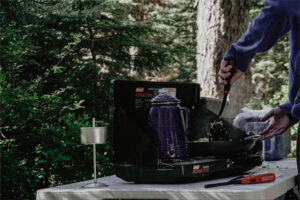
In this article, we’ll show you six simple ways to dispose of canisters from camp stoves. These procedures are universal and apply to disposable cylinders of nearly every brand of propane and isobutane/propane tiny gas canisters.
Are empty camping gas canisters considered hazardous waste?
Yes. Camping gas canisters that are empty but not punctured are considered hazardous waste. The reason for this is that, even if the gas canister seems to be empty and incapable of supporting a flame, it still contains residual gas. If ignited, such gas might produce an explosion. The safest approach to eliminate this risk is to empty the gas canisters.
How to dispose of camping gas canisters – 5 simple methods
- Recycle in your recycling bin
Every locality is different. Many companies accept empty Jetboil-style camping gas canisters as part of their standard steel recycling program. Simply puncture the canister to thoroughly remove any residual gasoline. Jetboil offers the Crunchit Recycling Tool, which makes emptying camping gas containers straightforward.
Many recycling systems are stricter for 1 lb propane cylinders (Coleman propane tank). These too can be punctured, although many recycling systems do not accept them for curb side recycling.
- Contact your local recycling center
Your local trash management business may take disposable gas cylinders as part of their regular collection schedule. If not, they will understand how to dispose of camping gas canisters securely and legally. You just have to ask.
- Contact your local authorities and enquire about hazardous waste disposal
Many counties offer free or low-cost recycling drop-off facilities and hazardous waste disposal sites. Our country has a lot of drop-off locations with convenient hours where you may bring hazardous garbage, including camping gas canisters.
The only disadvantage of your local transfer station is that you normally need to save up a lot of them to make the journey worthwhile.
- Contact A Local Hazardous Waste Disposal Company
If the previous options do not work, seek for a hazardous waste removal firm in your region. While this alternative is not free, it will help keep these steel canisters out of landfills and dispose of them safely.
- Contact a propane tank dealer
The final alternative is to call a nearby propane dealer. They specialize in working with propane and other dangerous gasses and will most likely be able to assist you with disposing of your camping gas canisters.
- Find a gas bottle exchange in your area
Many companies that sell gas canisters will take empty canisters. Check with your local retail and outdoor stores to see if they would take them. some of the stores used to provide this service to consumers, but many stores have since stopped.
Can you puncture a camping gas canister safely at home?
Yes. Puncturing a camping gas canister is required for safe recycling. Several possibilities may be completed at home using simple tools and skills.
The most essential thing is to prevent producing a spark. Methods that produce a spark can ignite the residual gas in what appears to be an empty canister, causing it to explore.
Puncture your gas canister in a well-ventilated place, away from heat sources and open fires. This is compatible with all sorts of refillable camping gas cylinders.
STEP 1 – make sure your small canister is empty
This procedure might seem trivial, but it is the only method that reduces the chance of an explosion. The simplest method is to connect your empty gas cylinder to your camp stove, turn it on, and wait for the flame to die out. If your stove does not light, it is probably empty.
step 2 – poke a hole in the empty gas canister
There are multiple options. If you have a Jetboil or MSR canister, you may utilize the Jetboil Crunchit Recycling Tool.
That being stated, you do not require a specialized tool. You may use a can opener or, like we did, a screwdriver and hammer. Simply insert the screwdriver at the top of the canister, keep it firmly, and strike the end with a hammer. After a few attempts, you’ll puncture the metal and hear a small number of cases escape.
You don’t need to overthink this step. If you use common sense and take the precautions listed above, it is rather simple and not particularly harmful.
step 3 – recycle
Once the empty fuel canisters are free of any remaining fuel, they can be recycled as mixed metal. They are no longer considered hazardous garbage and do not require special treatment.
What not to do when disposing of camping gas canisters
Gases inside a gas canister are compressed into a liquid and held there at low pressure. Knowing this, it’s critical to prevent excessive amounts of pressure caused by being crushed with the general garbage. Pressurized gas cylinders should never be disposed of in landfills or waste dumps since they can constitute a major safety risk when compacted.
When disposing of empty camping gas canisters, there are a few things to avoid:
- Do not throw them away since they might cause an explosion when crushed.
- Avoid leaving gas in the canister. They have to be fully empty initially.
- Don’t keep gas bottles in hot areas.
- Do not put gas canisters in the garbage.
- Never leave a gas canister, empty or not, at a campaign site.
- Do not leave gas canisters out for council pickup.
Conclusion
There you have it, six safe ways to recycle your old containers. Empty gas canisters may be handled securely and recycled as part of your regular recycling program, as long as they have been punctured to remove any leftover flammable gas. The simplest way to dispose of your used canister is to empty it following the three processes outlined above and recycle it as part of a standard mixed metal recycling program.





